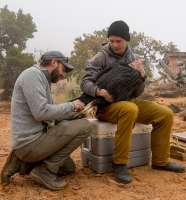A glimmer of hope arrived in Marble Canyon, Arizona over the past several days as emergency rescue teams took a breath and Vermilion Cliffs National Monument temperatures rose to 90 degrees. The unusually wet and cold winter conditions this year may have played a role in the occurrence and spread of Highly Pathogenic Avian Influenza (HPAI). While our crews are ready to recover and address the needs of more sick birds at any time, new signs of infection in our flock have decreased and some of the birds in supportive care are showing signs of improvement. The fight is far from over. Losses include 14 breeding-aged birds, 11 of which had recently been observed to be nesting or tending to young. In a matter of weeks, this event has set our recovery effort back a decade or more. Our science team is already analyzing emergency data to help define this long road to recovery. Before the outbreak of HPAI, the leading cause of death (accounting for 50% of confirmed mortalities) was lead poisoning. This new threat of HPAI, for which we do not yet have a solution (like a vaccine), highlights the need to address preventable and manageable threats, and rely even more heavily on proven strategies such as captive breeding to increase the wild population.
Peregrine Fund
Peregrine Fund
CHARITY STORY
California Condor Care

Photo Caption
Caring for California Condors in Arizona at the release site.
Photo Credit
Jim Shane
CHARITY VIDEO
Peregrine Fund

CFC Number
10639



